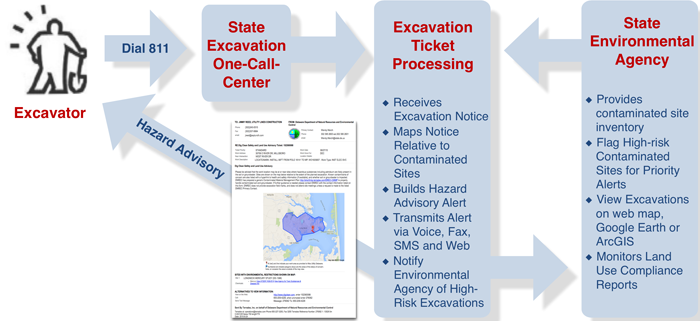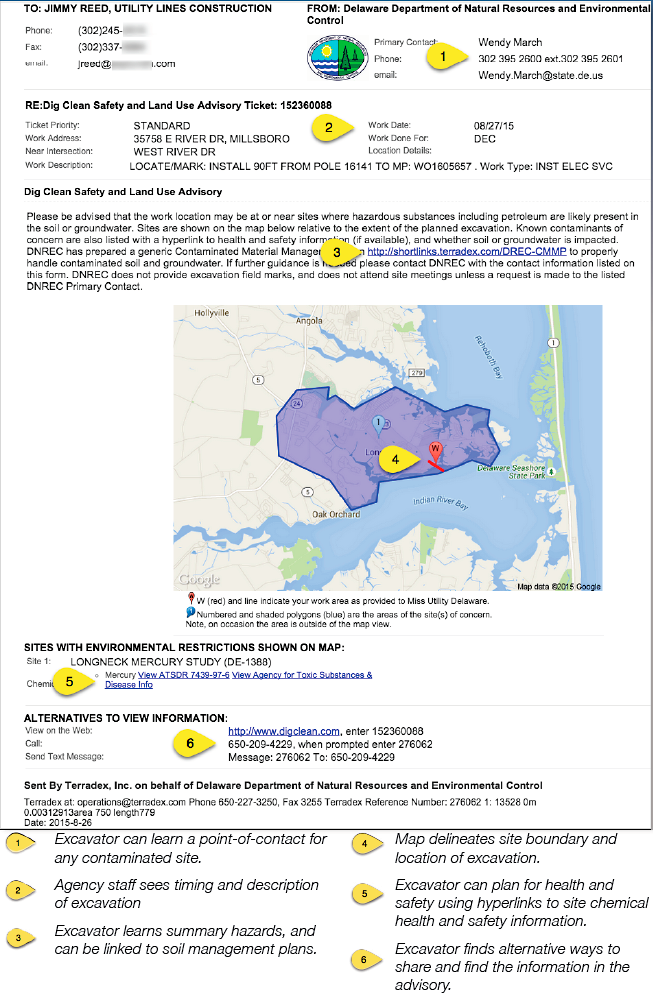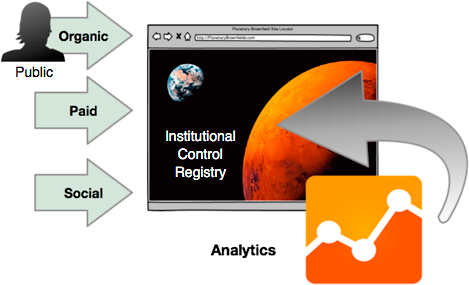Stakeholder Perspectives
One of the greatest stakeholder concerns about sites with long-term ICs is the ability to discover ICs into the future. After redevelopment of a brownfields site, it is difficult to determine the presence of an IC. The results from the ITRC survey showed about 41% reported IC failures were a direct result of inadequate communication. Additionally, because ECs are often integrated into a structure or paving, their integrity is not obvious. The challenge is heightened as the parties’ (such as the obligated parties) agency oversight is absent given the passing of time. The challenge then becomes the discovery of the IC or EC, and the ability to convey the knowledge of the IC or EC to the stakeholder. Stakeholder outreach includes identifying and involving internal and external stakeholders throughout the IC life cycle. An effective outreach program acknowledges the interests of all potential stakeholders, while seeking input from and communicating to stakeholders during the IC process.
An IC can only remain effective so long as it continues to be recognized, respected, and upheld by affected stakeholders. Not only does the awareness of a new IC need to be communicated to the affected community, but this awareness should be maintained throughout the life of the IC. As such, decision makers are in the position of ensuring that the stakeholders are aware of the IC, the constraints of the IC, and the duration of the IC. This responsibility is a challenge, since it requires resources from budgets that are often constrained.
Purpose of Outreach
The purpose of IC outreach is to identify, communicate and inform affected stakeholders and any other interested parties of an IC and identify appropriate actions to be taken in order to maintain its long term designed effectiveness to protect human health and the environment. Outreach is a working component of an IC throughout its life cycle and should be adaptable to maintain effective communication over both the short and long term.
An effective IC outreach and communication program is critical to maintain the protections afforded by an IC and should acknowledge the interests of all potential stakeholders, and strive to provide appropriate notifications or information. Stakeholders include not only current property owners or operators, but may include a variety of other entities such as financial partners or institutions, neighboring property owners or occupants/tenants, government agencies, or nongovernmental organizations
▼Read more
Outreach Communication Methods
Stakeholder outreach and the communication of risks and information associated with contaminated sites is typically initiated early in the site remediation process, sometimes as a result of emergency responses, or as part of notifying stakeholders of existing contamination during various phases of assessment, investigation or remediation. Outreach and communication (notification) typically continues, often mandated, into the long-term stewardship phase associated with ICs.
▼Read more
Passive Outreach (Pull)
In some cases, the residual risk posed by the subject property is deemed minor, and all that is required for stakeholder outreach is to notify the local health department and to file the ICs in the appropriate county property records. City clerks or local health departments may post notices in their offices.
Some states or local governments have developed geospatially referenced ICs to a database that posts to a public webpage with links to technical documents describing the ICs that are available to the public. These map-based applications can be a useful and an effective way for citizens to access information about ICs efficiently. Other web-based public notification tools could include a registry summary report that is accessible to any member of the public. Information about the properties may be presented in tabular form or on a map with links to information about the IC and relevant information that may be of interest to a viewer. Some states have monthly register notices, in which ICs could be published.
▼Read more
IC Summary Cover Sheet
A common IC cover sheet serves to inform the public and environmental professionals. One problem with ICs is that the critical and relevant information is encompassed in legal terminology that is not readily understood by the public. A uniform coversheet summarizes the location of the control, the restrictions put in place through the controls, the location and boundaries of the controls, and introduces the parties involved in the implementation of the control. As boundaries are described, common geographic standards such as latitude and longitude are used to delineate the boundary, even though the enforceable boundaries are based upon metes and bound legal descriptions or property identification numbers (PIN or APNs). PINS are subject to revision as properties are split and merged, and do not provide an enduring approach to describing IC boundaries.
Third-Party Data Sharing
Third party data sharing encompasses the syndicating or use of reputable environmental data by commercial, government, or nonprofit entities. The entities typically carry an audience that they are serving. An example of a commercial entity would be a Phase I environmental data provider that informs the real estate market of ICs. A government entity could be a local government or water agency that informs permit applicants of controls associated with property or water well development. A nonprofit may choose to inform public stakeholders of residual environmental contamination affiliated with an environmental justice mission they fulfill. Any agency that seeks to offer data sharing can consider web services that allow these parties to download or stream the environmental data. A representative download approach might be a Geographic Information Service (GIS) file, while a web service might be a Web Feature Service that serves environmental content in real time. The relevance of the Institutional Control Data Standard is clarified as many third party data services assimilate environmental data from multiple states, and having a common data standard eases their work.
Current Status of Outreach
Survey results indicate that a majority (65.2%) of states conduct some sort of outreach when an IC is implemented. The overwhelming majority of states report that their primary outreach contact is the current landowner (89.4%), with less than half (42.6%) contacting new landowners and roughly 20% of states surveyed contacting tenants and adjacent landowners. Over half of states (61.7%) surveyed report some sort of outreach to local government entities: but only about 20% to state government. A much smaller number of states (about 3-12%) report outreach to local citizens, such as citizen groups, homeowner’s associations, or local business owners. About 2% of states reported outreach to other interested stakeholders such as realtors, banks, and developers. Consultants were reported to have received notification from about 10% of survey respondents.
Outreach Moving Forward
In the future, the role of environmental oversight agencies may shift from guiding the remediation of a site to protecting the remedy. As the focus shifts to protectiveness, agencies may find that the integrity of the remedy is entrusted to diverse stakeholders that are close or direct activities at or near the remedy. As remediation is typically directed towards engineers and environmental scientists, the relevance of outreach is often a lower priority.
Therefore, agencies may find their interest in outreach increases in order to provide for protection of the remedy, but also to avoid the publicity and regulatory problems caused by remedy failure.
Given the diverse range of stakeholders including excavators, developers, and a public with English as a first or second language, outreach is multifaceted. An agency may soon be managing multiple channels of outreach to reach the variety of stakeholders that inadvertently could affect remedy effectiveness.
Agencies may find aligned partners that could help in their mission. For example, national local government planning associations might collaborate toward finding intuitive information to the planners they serve. Daycare associations may seek standardization toward supporting a common interest that daycare not be operated above sites with residual contamination. The Phase I due diligence industry may support data standards for the disclosure of ICs and ECs.
The use of data standards is also a future possibility. Data standards allow the IC information to be inserted into the information sources of government and business. An IC search might be started with a Google search, with results appearing in local government permitting, in water well development, or as new properties are occupied. Efficient data standards are needed in order to make this information ubiquitous and understood.
Data standards can memorialize the ICs as this data become assimilated into multiple commercial and public data services, each with their own copy that can persist across time. The role of the IC is to be a perpetual data message to future generations.
Outreach Best Practices
In order to successfully manage ICs throughout their life cycle (see Figure 2-1), robust outreach practices can provide ongoing information and continue to educate stakeholders. Best practices for IC outreach include the following components:
- Define stakeholders. It is critical to clearly identify who may be subject to, affected by, or have an interest in an IC and determine their relationship to specific use restrictions and the role that they play.
- Define information needs. Once stakeholders and their relationships to the IC have been determined, it is important to understand what motivates them, how they receive information, and whom they trust. This understanding informs future steps through the engagement process. Work to understand any barriers that could limit or prevent successful outreach.
- Define informational component. To the extent possible, tailor the outreach information to the needs of each stakeholder. It may be helpful to divide stakeholders into groups and subgroups and target them with information specific to their needs. (link to Appendix D)
- Translate messages into common local languages. For example, if there is a large Spanish-speaking population, consider providing translated materials.
- Present complex information using plain language and other means that the stakeholder can easily understand. Simplify information and use an appropriate reading level. Scientific information can be particularly difficult to comprehend for a nontechnical audience. If warranted, include the use of visual imagery.
- Identify and implement outreach methods. Determine methods to provide or make accessible necessary information to stakeholders. This approach can include direct and passive outreach methodologies as summarized in Sections 6.2.2 and 6.3.2, respectively. Outreach methods can be revisited throughout the lifespan of an IC to increase their effectiveness. These methods could include refocusing or strengthening those methods already in place as well as introducing new methodologies.
- Search and social media. Prepare the IC registry website for organic search discovery including the use of keywords, hyperlinks and site maps. Given that a state agency generally has a high reputation, a search engine inherently prioritizes search results from an agency. Thus, focusing on organic search over paid search is a prudent and cost effective strategy to increase outreach. Social media can introduce an agency’s interest to the public audience that otherwise might not consider searching for the content. Agencies can develop Facebook, LinkedIn, and Twitter accounts to publicize the content with use of keywords that would be common to the target audience.





